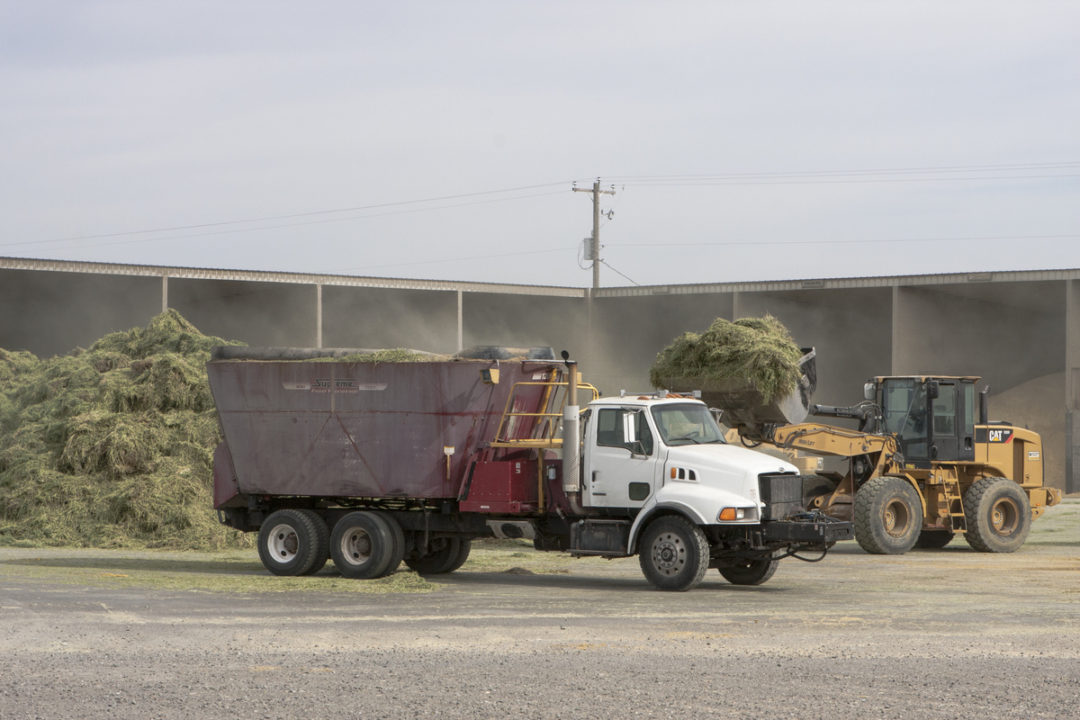The evolution of how we make feed for cows is truly amazing. Experienced farmers may remember riding with their fathers to the local mill to have feed ground, mixed, bagged and delivered to a feed room. Fast-forward to today and some farms are building feed centers, which can be thought of as on-farm feed mills.
Several factors drive this evolution, and each step comes with big learning curves. Feed shrink is one major factor. For example, let’s use $500 per ton for a commodity. It seems great to save $25 per ton by receiving a direct load into an open feed bay on the farm. But then your farm gets hit by a massive windstorm or a big flock of birds comes in for a feeding, and you realize that 10% of the commodity was lost, costing you $50 per ton.
Wind and rain can make it challenging to load a TMR mixer from commodity bays as well as feed bins. Mixing errors happen to even the best feeders. Birds and rodents challenge systems by causing shrink or equipment malfunctions. In other cases, you might not be able to identify the causes of shrink and find yourself frustrated when the feed budget never comes close to being met. In addition to reducing shrink, farms are considering feed centers in the interest of time efficiency by reducing the steps or wheel traffic to load a TMR mixer.
Efficiently managing labor is a part of this picture. More of employees’ time can be spent making decisions rather than burning fuel and wearing out tires and concrete.
Know where you are and where you want to be
The first step in improving your feed management system – and potentially investing in a feed center – is identifying your best opportunities to improve efficiency. This requires having a system in place to measure the effectiveness and efficiency of your current feeding program to guide any changes you make. As feeding management programs increasingly become available, tracking deliveries and feed used is a big part in justifying the next step you take in your feed center.
Let’s say you had 40 tons of that $500-per-ton commodity delivered, but your data shows you had only fed 36 tons when it was gone. The missing 4 tons equals a loss of $2,000 in shrink. Knowing these numbers can help you justify your investment and set a budget for a feed center.
Learn from your peers
Make it a priority to tour different feed centers. Lean on your consultants to help you see a variety of facilities and management systems. This will lead to conversations about how to measure shrink, correctly size bays, position doors and ramps, organize products, clean and purchase necessary equipment.
Building considerations
Most bays are going to be 24 to 32 feet wide and 30 to 40 feet deep. These dimensions are common, as they allow trucks to back into them and allow for old feed to be removed while new feed is delivered. Traffic flow plans need to be well thought out. In an entirely enclosed commodity shed, it is beneficial to have two large doors for entering and exiting. With just one door, it’s challenging for large trucks to turn around.
Additionally, in many parts of the U.S., trucks drive in less-than-ideal winter weather and create a mess of dripping road salt in the shed. Discussing plans to minimize and manage these types of challenges is importan
Good lighting in the building for deliveries, feeding and cleaning is essential. Think about the impacts various environmental conditions can have in the feed center. You might consider some form of mechanical ventilation to reduce condensation or handle dust that’s created by moving feed as part of the process for keeping the center clean.
TMR mixing
One of the biggest benefits of recently built feed centers is loading the TMR mixer (either stationary or portable) inside so weather does not challenge the process. Anyone who has watched feed blow away on a windy day should instantly understand the value of mixing the TMR indoors. Furthermore, loading inside means the feeder doesn’t have to try to see through windows during a heavy rainstorm.
This helps keep the feeder moving and enhances safety with improved lines of vision if someone walks through the loading area. In many modern feed centers using a portable TMR mixer, the loading position is usually slightly recessed into a pit compared to the rest of the floor. When built correctly, the solid floor will help keep the mixer level when loading and mixing, which is a critical aspect of properly mixing feed.
Having a recessed pit helps the feeder view into the mixer from the loading apparatus and keep a good height for any feed bin augers. This setup also allows the feeder to mark different targets to find the center of the mixer more easily, as that is critical to creating a consistent TMR mix.
Bays and bins
Having bays for wet or bulky ingredients makes sense. We are now seeing farms use feed center bays for forages as well as commodities. In these systems, defaced forages are moved from the forage storage area into bays to speed up the loading process and also create a better blend of the forages loaded into the TMR. Moving the forages inside can create an advantage of fewer rain-affected moisture changes or sun-induced heating.
Many systems use forage boxes to load forage from the pile or bunker and deliver to the appropriately labeled bay in the commodity center. The timing of this activity can be adjusted some to take advantage of the best weather window available on the inclement days. Sizing feed bays or bins to handle more than a semi-load of an ingredient is important. Freight logistics has not been a friendly topic in recent history, and I’ve visited many farms that are ecstatic to have room for two or three semi-loads of an ingredient given current market conditions.
Automation
Automation is most frequently set up for feed bins; it can be a significant time saver as well as an opportunity to reduce loading errors of what are usually the highest-priced ingredients. With advancements in technology, controlling mixing accuracy and reducing labor is a piece of the feed center puzzle.
As such, when designing a feed center, consider whether you want to move toward automation today or design your facility in a way that automation may be introduced in the future. This might include an area that could house a stationary mixer or a preloading hopper capable of loading into a portable mixer.
Ask a lot of questions and then ask more
As you design your feed center, you’ll need to ask yourself many questions. Does the feed center need an office where you can check ingredient dry matter, make ration updates and track orders? Do you need a spot to store tools for quick repairs? Is a truck scale needed and should it be near the feed center? Is an on-site grain center a source of an ingredient? Can an existing feed center be adapted to accomplish some of your objective?
For most of the process, you’ll likely feel like you have more questions than answers, but those questions will help you better track current processes, set goals and ultimately develop your farm’s ideal feed center.







